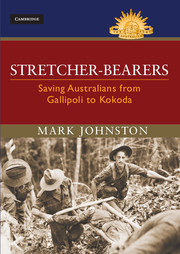Introduction
Published online by Cambridge University Press: 18 December 2014
Summary
Serving Australia and serving humanity
In World War I, about 60 000 Australian soldiers were killed and more than 155 000 wounded. In World War II, the respective figures were nearly 19 000 and more than 22 000. It was the job of stretcher-bearers to alleviate the suffering of the human beings behind those numbers. The cry of ‘Stretcher-bearer!’ was heard on every Australian front in both world wars, from Gallipoli to Kokoda, the Somme to Tobruk, Beersheba to Borneo. And wherever and whenever it was heard, with no exceptions, Australian stretcher-bearers believed they must respond to it.
The impulse to remove the wounded from the battlefield is as old as warfare itself. Before the nineteenth century, armies did not employ systematic means of evacuating their wounded. An aristocrat might be helped to safety by his retainers, but the wounded common soldier’s main hope of succour was from comrades who might put him on a shield or carry him on their shoulders, although this practice was officially discouraged because it removed not only the wounded but also able-bodied men from the fray.
The early nineteenth century brought the first signs of a systematic approach to saving the wounded. Among Napoleon Bonaparte’s forces, Baron Percy organised brancardiers (from brancard, or stretcher) to remove casualties, while Baron Larrey introduced ambulance wagons and mobile hospitals. The Duke of Wellington’s chief medical officer, Sir James McGrigor, created field hospitals, emphasised hygiene and established his status as the father of the Royal Army Medical Corps. Nevertheless, at Waterloo in 1815, the evacuation of casualties was still haphazard. Bandsmen, apart from drummers, were entrusted with bringing the wounded to the nearest surgeon. They were not trained, not provided with stretchers and were few in number at a battle where tens of thousands were wounded. They dragged or carried casualties to help, often on makeshift stretchers such as blankets, planks and doors. The lucky went on a horse or spare horse-drawn vehicle.
- Type
- Chapter
- Information
- Stretcher-bearersSaving Australians from Gallipoli to Kokoda, pp. 1 - 23Publisher: Cambridge University PressPrint publication year: 2014

